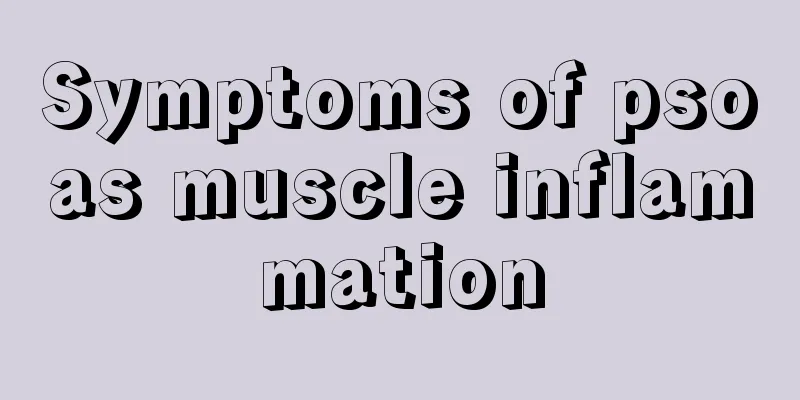Symptoms of psoas muscle inflammation

|
Exercise can make the body healthier, but the amount and method of exercise are very important. Many people do not care about this and injure their waist during exercise. In particular, the symptoms of lumbar muscle inflammation should be fully understood. Patients with lumbar muscle inflammation will feel intense pain, and sometimes extreme stiffness. The pain in the lumbar muscles will be more severe after getting up in the morning, and can only be relieved through activity, which greatly affects their lives. 1. What are the symptoms of lumbar muscle inflammation? 1. Back of the neck If the muscles behind the neck are inflamed, the patient will feel severe pain and stiffness in the back of the neck, as well as a very obvious feeling of heaviness. These symptoms will be particularly obvious when getting up in the morning. After a short period of activity, the symptoms will be alleviated. 2. Neck and Shoulders When the muscles in the neck and shoulders become inflamed, they will feel noticeably stiff and numb, and this symptom will also spread to the head and upper limbs. The symptoms will worsen every morning and when there are significant changes in the weather. Although the symptoms will be alleviated after a little activity, they will recur. 3. Psoas Patients with acute lumbar muscle inflammation will have very severe lower back pain symptoms, accompanied by a burning sensation. If the lower back is moved, the pain symptoms will only become more severe. If you are already a patient with chronic psoas muscle inflammation, you will often feel soreness and heaviness in the psoas muscle area. 4. Others The main symptoms of lumbar muscle strain are soreness and pain in the waist. Severe lumbago is often accompanied by lumbar muscle tension spasm and difficulty bending over. Severe cases may affect daily work and life. Practice has shown that exercise therapy has a good effect on it. It is recommended that you pay attention to maintenance, keep warm, avoid strenuous exercise, and you will gradually return to normal. 2. Four major causes of lumbar muscle inflammation 1. Cumulative damage: The muscles and ligaments of the waist are often stretched during daily life and work. Tissues that are subjected to large and frequent forces may experience small fiber ruptures, bleeding and exudation. After the broken tissue is repaired and the bleeding and exudate are absorbed, scars and tissue adhesions may remain. These tissues can easily pull and compress the intrinsic nerve fibers, causing low back pain. This type of back pain is relieved after rest, worsens after fatigue, and may even make it impossible to maintain a certain posture for a long time. 2. Prolonged acute lumbar sprain: If acute lumbar sprain is not treated thoroughly in the acute phase, the damaged muscles, fascia, and ligaments will not be repaired properly, resulting in more scars and adhesions, which will reduce lumbar function and cause pain. Patients often feel weakness in the waist, and have back pain on rainy days, which will persist for a long time. 3. Aseptic inflammation of lumbar muscle fascia: Long-term bending over or sitting work will cause the back muscles to be stretched for a long time, resulting in spasm, ischemia, edema, adhesion, etc. Some people call it aseptic inflammation. 4. Others: Congenital spinal deformities and functional or structural defects of the lower limbs can lead to strain on the low back tissues. Physical weakness and visceral diseases can also reduce the stress resistance of the lower back. The increased weight on the waist in late pregnancy can also easily cause strain. 3. Treatment of psoas myositis Rubbing: Sit down, put the five fingers of both hands together, and place them on the left and right lumbar vertebrae, with the palms facing inward, and rub up and down slowly until they become warm. Roll: Make fists with both hands, place them on the waist and roll and massage around, from bottom to top, from top to bottom, repeatedly. The head can be tilted forward or backward. Push: After rubbing your hands together until they are warm, overlap them and place them in the middle of the lumbar spine. Push and rub from top to bottom 30-50 times until a local warm feeling is generated. Press: Put your hands on your waist and press your thumbs on the waist points. Squeeze hard and rotate and knead, first clockwise and then counterclockwise, 36 circles each. Pinch: Sit with your legs stretched forward, or bend your knees, or sit upright. Use both hands to pinch, lift and release the waist muscles 15-20 times. Tap: Make fists with both hands, with the palms facing outwards, and tap the waist lightly without causing pain. Do this on both sides at the same time, 30 times each. Grab: Put your hands behind your waist, with your thumbs in front, pressing on the sides of your waist without moving. Use the other four fingers to scratch the skin on both sides of the lumbar vertebrae outwards, from the waist to the tail. Do this with both hands at the same time, 36 times each. Shake: Place both hands on the waist, press the waist with the base of the palms, and shake up and down quickly 15-20 times with the palms facing inward. Press: Sit down and press and rub the Ren Zhong point with the middle fingertips of the left or right hand for 1-2 minutes. Press: Sit down and use the middle fingertips of both hands to press the Weizhong points on both legs (behind the knee joint) for 1-2 minutes until the pressed areas feel sore, numb, or swollen. |
>>: What to do if you have back pain
Recommend
Why does white coating on tongue cause dry mouth?
Recently I found white coating on my tongue and d...
What kind of radiation protection suit is good
Many anti-radiation clothing for pregnant mothers...
Prevention of mumps
Each of us cannot live without food every day, an...
Suffering from colorectal cancer onset period
The main risk factors of colorectal cancer are: F...
It turns out that hypoglycemia aphasia is caused by such factors
Hypoglycemia is a common phenomenon in daily life...
What are the more obvious symptoms of cheilitis
Cheilitis is a common disease of the lip skin, an...
Will the natural life expectancy of tongue cancer patients be reduced?
Both Chinese and Western medicine have good exper...
What are the symptoms of advanced kidney cancer
What are the symptoms of advanced kidney cancer? ...
What to do if the corners of mouth peel like ringworm
In some seasons, the air becomes drier, and many ...
Is a heart rate of 112 normal?
The pace of life of modern people is very fast, e...
What are mental illnesses? Various types of mental illness
Due to the great pressure of survival in modern t...
How to treat pituitary tumor with acute stroke
Pituitary stroke is mainly caused by pituitary ad...
What are the symptoms of spleen deficiency, cold stomach and excessive liver fire?
Spleen deficiency, cold stomach and hyperactivity...
What are the symptoms of a cold
The two most common types of colds are wind-cold ...
It is best to take a bath every few days, this is healthy
People take a bath frequently, which can help rem...









